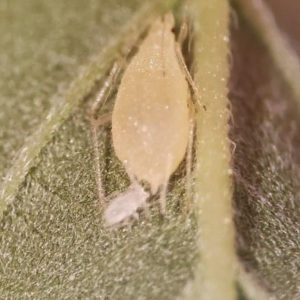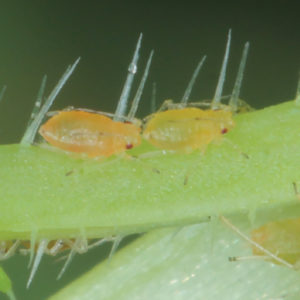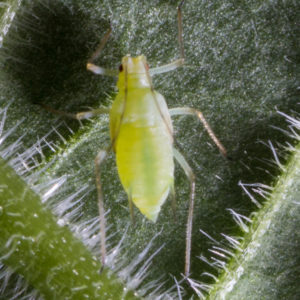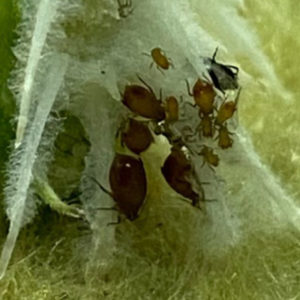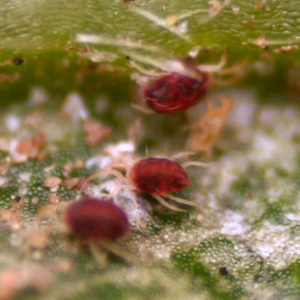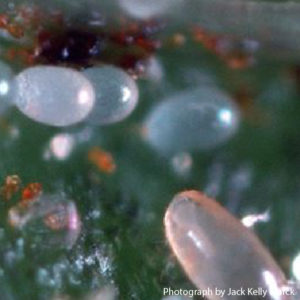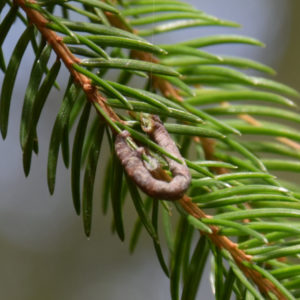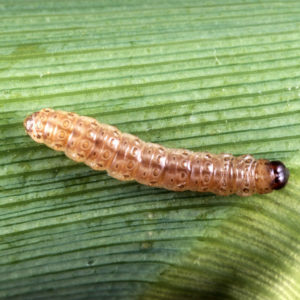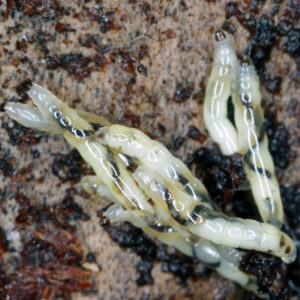There are many species of Aphids (peach potato aphid, cotton aphid, potato aphid, cannabis aphid, rice root aphid, foxglove aphid), while some are host specific (monophagous), others feed on many plant species (polyphagus). Aphids come in many colors (white, black, brown, gray, yellow, light green, or even pink) and can also vary considerably within the species. Some may have a waxy or woolly coating. Scouting and identification are key to using appropriate control strategies.
Cannabis aphid
The cannabis aphid (Phorodon cannabis) is pale yellow and later turn light green or pink with darker green stripes running the length of the body.
Blackberry aphid
The large blackberry aphid are host specific, they are pale or yellowish green with pale cornicles. The body length is 2-5 mm and the cauda is short and triangular. Adults may be winged and wingless. Blackberry aphids feed on the young growth and can quickly damage young plants. Aphid colonies can lead to the decline of plants and reduce yield, if left unchecked.
Cotton aphid
The cotton aphid (Aphis gossypii) is found on more than 700 plant species.
Foxglove aphid
The foxglove aphid (Aulacorthum solani) is also known as the glasshouse-potato aphid; yellow to pale green, it is capable of infesting a wide variety of ornamental and vegetable plants.
Green peach aphid
The green peach aphid (Myzus persicae) can be yellowish-green, red, or brown in color because of morphological differences influenced primarily by the host plants, nutrition and temperature.
Potato Aphids
Potato aphids (Macrosiphum euphorbiae) prefer feeding on plants in the Chenopodiaceae family. They can appear green or reddish-pink; may be winged or wingless and have a preference for Solanaceae plants (potatoes in particular) yet have been identified in many vegetable and ornamental crops; therefore, scouting and identification are key.
Rice root aphid
Rice root aphids (Rhopalosiphum rufiabdominalis) also known as the red rice root aphid, prefer soil and media surroundings, making it difficult to detect. They can appear dark green to brown with yellow or red tinges and like most aphids, may be winged or wingless. The winged rice root aphid will emerge to colonize new plants. Female rice root aphids give live birth to genetically identical daughter offspring that mature quickly. Nymphs and adults feed on all plant development stages.
Tobacco aphid
The tobacco aphid (Myzus persicae subsp. nicotianae), a key pest in tobacco crops is also encountered in a wide range of greenhouse crops such as sweet pepper, eggplant, chrysanthemum and ornamental crops.
Spider mites
There are many species of spider mites (around 1,200 species) all belonging to the family Tetranychidae. They generally prefer living in the undersides of leaves, where they spin protective silk webs which are also used as a means to protect their colonies as well as to travel from plant to plant. Spider mites can be difficult to spot but if unchecked, later move to the upper leaves. Spider mites vary in color, thus scouting and identification are key.
Broad mites
The broad mite (Polyphagotarsonemus latus), is a small species of mite found on many species of plants, including important agricultural crops such as grapes, cannabis, sweet pepper, chili peppers, eggplant, cucumber, ornamentals and others. The mite’s oval-shaped eggs are laid on the underside of the leaf or on fruit surfaces. The mites prefer areas of high humidity and low temperature and are a major pest in greenhouses.
Citrus red mite
Adult Citrus red mites (Panonychus citri) are dark red, bordering on purple and their eggs are also dark red. The mites disperse by holding on to a silken thread they produce, and floating on air streams. The citrus red mite is most often associated with citrus but may infest pears, almond, roses and other broad-leaved ornamentals.
Cyclamen mite
Cyclamen mite (Phytonemus pallidus) are tiny mites (less than 0.5mm long) that feed on plant sap by penetrating the plant tissue with its piercing-sucking mouth parts. The mites are mostly found on the underside of leaves, within the flower buds, growing tips and young folded leaves, away from direct sunlight.
European red mite
The European red mite (Panonychus ulmi), also known as the fruit tree red mite attacks fruit trees but can also be a problem in grape vines, ornamentals and roses. The European red mite does not produce large amounts of webbing like the two-spotted spider mite (Tetranychus urticae). The female lays its eggs on the leaves and overwinters in the egg stage. In temperate climates, the “winter eggs” are laid in the wooden parts of the host plants in autumn.
Carmine spider mite
Carmine spider mites (Tetranychus cinnabarinus) are similar to the citrus red mite, oval but are a brighter red color with prominent legs.
Russet mite
There are many species of russet mites: the tomato russet mite (Aculops lycopersici), the citrus russet mite (Phyllocoptruta oleivora), the hemp russet mite (Aculops cannibicola) and many others. Adults and nymphs may appear white, tan, pink or yellow and are almost invisible to the naked eye. Russet mites do not produce the webbing, thus may go unnoticed until there is a build-up of a large population as well as visible damage.
Two-spotted spider mite
Two-spotted spider mite (Tetranychus urticae) is oval and has two dark spots on either side of the body. This mite may be brown, orange-red or greenish-yellow in color. Two-spotted spider mite lays its eggs on the leaves. It attacks well over 100 species of cultivated crops and weeds and is a serious pest on peppers, tomatoes, strawberries, cucurbits and other vegetables, ornamentals, flowers and fruit trees.
Mealybugs
Mealybug is a pest which can have a considerable negative economic impact on a wide range of ornamental and agricultural crops. Since there are many species of mealybugs, scouting and identification are crucial. Sexually dimorphic, adult female mealybugs are much larger, retain the appearance of younger stages and lack wings while the adult males are much smaller and develop into mosquito-like insects with wings.
Citrus mealybug
The citrus mealybug (Planococcus citri) can be recognized by a slightly darker, longitudinal, dorso-median stripe and it’s orange-brown color with medium length wax filaments at the body margins. The adult female lays amber-yellow eggs in a fluffy posterior ovisac.
Cotton mealybug
The cotton mealybug (Phenacoccus solenopsis) has two broken grey sub-median longitudinal stripes and very short lateral wax filaments.
Longtailed mealybug
The longtailed mealybug (Pseudococcus longispinus) is easily recognizable by its broad dorso-medial line and 4 very long posterior tails as well as the long lateral wax filaments. This particular mealybug gives birth to live nymphs and does not produce egg masses.
Vine mealybug
The vine mealybug can be identified by a dark thin dorso-medial line of denuded wax; it can be found on roots as well as above ground. DAMAGE A high population of mealybugs can lead to: fruit drop, fruit deformation and development of discolored welts on the rind of the fruit. Mealybug secrete copious quantities of […]
Thrips
There are many species of thrips, approximately 6,000 species have been described by entomologists. Thrips are worldwide pests with a wide range of host plants, the main ones being vegetable crops, field crops, flowers, fruit trees, citrus and many ornamental plants. Some thrips are predators of other insects or mites, thus scouting and identification are crucial.
Chilli Thrips
Chilli thrips (Scirtothrips dorsalis) is a widely distributed pest with a broad range of host plants, including pepper, mango, citrus, strawberry, grapes, cotton, tea, blueberry and roses. The chilli thrips is a small insect (< 2mm) with a narrow body and tightly folded wings forming a dark stripe along the lower abdomen.
Western flower thrips
The western Flower Thrips (Frankliniella occidentalis) is a worldwide pest with a wide range of host plants. A year-round invasive pest, they are less destructive during wet weather. The western flower thrips is a small insect with a narrow body (up to 1.2 mm in length) and yellowish in color.
Whiteflies
Whiteflies are small sap-sucking insects that typically feed on the undersides of plant leaves and can inflict direct and indirect damage to a wide variety of crops and ornamentals.
Greenhouse whitefly (GHW)
The greenhouse whitefly (Trialeurodes vaporariorum), sometimes referred to as the glasshouse whitefly, prefer to lay their eggs on the undersides of leaves.
Sweet-potato whitefly (SPW)
The sweet-potato whitefly (Bemisia tabaci) is sometimes referred to as the silverleaf whitefly. Outbreaks of sweet potato whitefly occur worldwide, resulting in yield loss and economic injury in a wide array of crops.
Leaf miner
There are numerous species of leaf miners: the American serpentine leaf miner, the tomato leaf miner, the pea leaf miner as well as insects in which the larval stage lives in and nourishes itself from the plants leaf tissue.
Chrysanthemum leaf miner
Adults Chrysanthemum leaf miners (Chromatomyia syngenesiae) are small, black to gray flies with yellow markings. The females puncture leaves to feed on plant sap and lay eggs within the leaf tissues. The larval stage lives in and nourishes itself from the plants leaf tissue.
Diamondback moth
Diamondback moth (Plutella xylostella), sometimes known as the cabbage moth, are widespread pests of brassica crops. Adults are small slender grey-brown moths with a lighter band along its back which forms a diamond shape, from where they get their common name. Larvae are green and develop through four instars in about 3 to 4 weeks. The diamond moth eggs are oval and flattened, yellow or pale green in color. The females lay eggs only on the leaves of the Brassicaceae family. While the larvae are colorless in the first instar, they are pale or emerald green with black heads in later instars. Pupation occurs in a loose silk cocoon which are usually found on the lower or outer leaves of the host plant. Diamondback moth can undergo several generations in a crop cycle and form high populations if not controlled at an earlier stage. Moths can migrate long distances on the wind and also migrate between adjacent fields.
Spruce budworm
Diamondback moth (Plutella xylostella), sometimes known as the cabbage moth, are widespread pests of brassica crops. Adults are small slender grey-brown moths with a lighter band along its back which forms a diamond shape, from where they get their common name. Larvae are green and develop through four instars in about 3 to 4 weeks. The diamond moth eggs are oval and flattened, yellow or pale green in color. The females lay eggs only on the leaves of the Brassicaceae family. While the larvae are colorless in the first instar, they are pale or emerald green with black heads in later instars. Pupation occurs in a loose silk cocoon which are usually found on the lower or outer leaves of the host plant. Diamondback moth can undergo several generations in a crop cycle and form high populations if not controlled at an earlier stage. Moths can migrate long distances on the wind and also migrate between adjacent fields.
Leek moth
The Leek moth (Acrolepiopsis assectella) also known as the onion leaf miner is an invasive species in North America that attacks leeks and related Allium species. The female lays eggs on the leaves of the host plant. The larvae are light yellow-green in color with a brownish head. The first instar larvae form leaf mines, shaped like a corridor which then turns into a blotch and can be with or without frass.
Cabbage white
Cabbage white (also called imported cabbageworm or cabbage butterfly) are white butterfly with darker wing tips and eyespots in the forewings.. The larvae feed primarily on brassica plants with some secondary hosts in related families, e.g. Capparidaceae, Resedaceae. P. rapae eggs are yellowish with 12 longitudinal ridges. The caterpillars are bluish-green in color with tiny black pints, a lateral row of yellow dashes and a yellow middorsal line. During the pupal stage the cabbage white is brown-grey or yellowish (matching the background).
Cabbage looper
Cabbage loopers (Trichoplusia ni) is a type of cabbage worm that attack cruciferous vegetables, including cabbage, bok choy, broccoli, beans, lettuce, cotton as well as ornamental plants such as chrysanthemum. The eggs are generally yellow-white in color, dome-shaped and patterned with ridges. The larvae are pale green, often with a white stripe along the side and have a distinctive looping walk, from which they get their common name. Pupation occurs in the undersides of leaves, where they form a silky cocoon. Adults are medium sized brown moths and can undergo several generations in a crop cycle.
Cabbage loopers can inflict various kinds of damage on a crop.
Leafrollers
Leafrollers are the larvae of some tortricid moths, with bodies ranging in color from green to brown. The larvae feed and pupate within rolled-up leaves of the host plant which are tied with silk threads to provide protection. Many of the moth species adults are drab and have mottled and marbled brown colors. Several species cause problems on ornamental and fruit trees. Examples include the obliquebanded leafroller (Choristoneura rosaceana), the omnivorous leafroller (Platynota stultana) and the codling moth (Cydia pomonella) which can be important pests of fruit trees.
Cutworms
Cutworms are the larval stage of certain owlet moths that hide in the soil during the day and feed on plants at night. Although the eggs vary in color, they all have a spherical shape. The larvae have a smooth appearance with green, brown, grey or yellow colors and the pupae, most often, range from shiny brown to dark brown. The adults are medium sized brown or grey moths. Many species of owlet moths are considered an agricultural problem around the world. As general feeders, they attack a wide range of vegetables (asparagus, beans, cabbage, carrots, corn, lettuce, peas, peppers and tomatoes) and ornamentals.
Raspberry fruitworm
The raspberry fruitworm (Byturus unicolor) is a type of fruitworm beetle in the Byturidae family. It is also known as the western raspberry fruitworm and fruitworm beetle. Adults are 4-5 mm long, small yellowish-brown oval shaped beetles. The larvae are white with darker areas on the top of each body segment and develop in the berries of various Rubus plants. When the larvae reach maturity, they drop to the ground, burrow into the soil and pupate. Adult beetles overwinter in the soil and emerge in the spring feeding on fruit buds, young leaves and flowers.
European corn borer
European corn borer (Ostrinia nubilalis) also known as the European corn worm or European high-flyer has a wide host range, attacking many herbaceous plants with a stem large enough for larvae to enter. The western strain attacks corn and other vegetables before corn is available, or late season when corn becomes senescent. Crops attacked include beans, pepper, potato, cannabis, hemp, hops and oats. The adult females lay clusters of whitish-yellow eggs on the underside of corn leaves, as the eggs develop they become transparent and the black heads of the caterpillars become visible (see above picture). The larva vary in color from light brown to pinkish gray with small brown spots along the body. The adult female is light yellowish-brown with darker irregular wavy bands across the wings while the male is smaller and darker. A female can lay a total of 400 to 600 eggs during her adult life.
Tuta Absoluta
Tuta absoluta, also known as the tomato leaf miner, tomato pinworm and South American tomato moth, is a major pest of field and greenhouse-grown tomatoes. Adult moths are grey-brown, while newly hatched caterpillars are yellowish and small.
Codling moth
The codling moth (Cydia pomonella) is a member of the Lepidopteran family Tortricidae. Not large, they are distinguished from other moths by the golden patterns on their fore-wings: brown spots enclosed in gold, coppery bands. The codling moth young larvae are white with black heads while mature larvae are pinkish white with brown heads. The preferred host plants are apple and pear trees.
Black vine weevil
The black vine weevil (Otiorhynchus sulcatus), also known as the taxus weevil or cyclamen grub, is matte black with fused wing covers
Pepper weevil
The pepper weevil (Anthonomus eugenii) feeds and lays eggs on sweet peppers (Capsicum annum), chilli peppers (Capsicum frutescens) and other solanum species such as eggplant and tomato.
Strawberry root weevil
The Strawberry root weevil (Otiorhynchus ovatus) gets its name from their preference for strawberry plants yet they are also known to feed on raspberry, rhododendron, grape and peppermint.
Japanese beetle
The Japanese beetle (Popillia japonica) is among the most damaging scarab beetles that infest turfgrasses in North America, Canada and Europe.
White Grubs
White grubs are the larval or grub stage of several species of weevils and chafers beetles.
Fungus gnats
Fungus gnats (Sciarids), also called dark-winged fungus gnats, are small, dark, delicate-looking flies that infest soil, potting mixes, container media and sources of organic decomposition.. Adult fungus gnats have light gray to clear wings and slender legs with segmented antennae that are longer than their head. Females lay tiny eggs in moist organic debris or potting soil.
Shore fly
Shore flies (Ephydridae) are minute flies ranging from black to gray in color, that prefer moist environments. Adults and larvae feed on algae and decaying organic matter in planting substrate.

